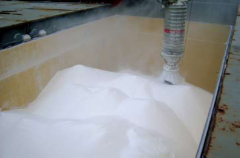Soda ash
| Infobox on Soda ash | |
|---|---|
| Example of Soda ash |  |
| Facts | |
| Origin | - |
| Stowage factor (in m3/t) | 0,95 to 1,67 m3/t |
| Humidity / moisture | - |
| Ventilation | No special requirements |
| Risk factors | See text |
Soda ash
Description
Sodium carbonate (also known as washing soda or soda ash), Na2CO3 is a sodium salt of carbonic acid. It most commonly occurs as a crystalline heptahydrate, which readily effloresces to form a greyish-white powder, the monohydrate. Sodium carbonate is domestically well known for its everyday use as a water softener. It can be extracted from the ashes of many plants. It is synthetically produced in large quantities from table salt and limestone in a process known as the Solvay process.
Application
Use; glass manufacture, chemicals, pulp and paper manufacture, sodium compounds, soaps and detergents, water treatment, aluminium production, textile processing, cleaning preparations, petroleum refining, sealing ponds from leakage (sodium ions bind to clay particles, which swell to seal leaks), catalyst in coal liquefaction.
Shipment / Storage / Risk factors
Soda ash is shipped in bulk, barrels, bags or drums.
Subject to loss in weight. Also may increase in weight due to the absorption of moisture.
Any substantial contamination of soda ash by liquid water, as distinct from water vapour in the atmosphere, will make it unfit for glass making. Soda ash is ruined on contact with oil.
Containers must be absolutely clean, free from rust and dry. Soda-ash affects steel structures. An innerliner should be fitted inside the container for receiving this cargo.
See IMSBC Code (International Maritime Solid Bulk Cargoes Code) for overseas transport advice. Also consult the applicable MSDS sheet for safe handling advice.











